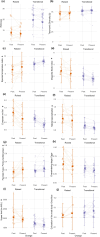Highly Conserved Ecosystems Facing Climate Change: Rapid Shifts in Odonata Assemblages of Central European Bogs
- PMID: 40202095
- PMCID: PMC11980027
- DOI: 10.1111/gcb.70183
Highly Conserved Ecosystems Facing Climate Change: Rapid Shifts in Odonata Assemblages of Central European Bogs
Abstract
Freshwater diversity is declining at an alarming rate worldwide, and climate change is a key driver. However, attributing biological shifts solely to climate warming remains challenging because of confounding anthropogenic stressors. Peatbogs, being highly conserved, strictly protected, and minimally disturbed, offer a unique study system to isolate climate effects. We compared odonate assemblages in 27 Central European raised and transitional bogs between two sets of standardized surveys approximately 20 years apart (1998-2006 and 2020-2024). During this period, the mean annual air temperature has increased by 1.23°C. We tracked species richness, composition, taxonomic diversity, and functional traits (thermal tolerance, conservation value indicators, and selected morphological and life-history traits) and also examined phylogenetic patterns of species turnover. Although species richness remained stable, assemblage composition shifted markedly from cold-adapted, vulnerable bog specialists toward warm-adapted habitat generalists with lower conservation value. Notably, Ponto-Mediterranean species and those with a lower upper elevational limit increased their occupancy. Although the phylogenetic signal across the evolutionary tree of odonates was low, implying that the responses of the species to climate change were independent of their phylogenetic position, we revealed frequent genus-level replacements. These findings reinforce the position of odonates as a model group for detecting climate-driven changes in freshwater communities. Our study has revealed that climate warming alone can trigger profound reorganization of insect communities in inherently stable peatbog habitats. Specific traits linked to vulnerability (e.g., thermal index, red list status) and specialization proved to be promising predictors of future shifts in odonatofauna of temperate peatlands. The pronounced changes documented here may precede irreversible transformations of these unique ecosystems, highlighting the urgency of monitoring bog habitats and maintaining their stability under ongoing global change.
Keywords: Dragonfly Biotic Index; European Red List; Odonata; Species Temperature Index; climate change; raised and transitional bogs; temperate peatlands; trait‐based approach.
© 2025 The Author(s). Global Change Biology published by John Wiley & Sons Ltd.
Conflict of interest statement
The authors declare no conflicts of interest.
Figures




Similar articles
-
Consistent signals of a warming climate in occupancy changes of three insect taxa over 40 years in central Europe.Glob Chang Biol. 2022 Jul;28(13):3998-4012. doi: 10.1111/gcb.16200. Epub 2022 May 10. Glob Chang Biol. 2022. PMID: 35535680
-
Species composition, distribution and habitat types of Odonata in the iSimangaliso Wetland Park, KwaZulu-Natal, South Africa and the associated conservation implications.PLoS One. 2014 Mar 24;9(3):e92588. doi: 10.1371/journal.pone.0092588. eCollection 2014. PLoS One. 2014. PMID: 24662948 Free PMC article.
-
Differentiating the effects of climate and land use change on European biodiversity: A scenario analysis.Ambio. 2017 Apr;46(3):277-290. doi: 10.1007/s13280-016-0840-3. Epub 2016 Nov 1. Ambio. 2017. PMID: 27804097 Free PMC article.
-
Phenological and elevational shifts of plants, animals and fungi under climate change in the European Alps.Biol Rev Camb Philos Soc. 2021 Oct;96(5):1816-1835. doi: 10.1111/brv.12727. Epub 2021 Apr 27. Biol Rev Camb Philos Soc. 2021. PMID: 33908168 Review.
-
Resident species, not immigrants, drive reorganization of estuarine fish assemblages in response to warming.Ecology. 2023 May;104(5):e3987. doi: 10.1002/ecy.3987. Epub 2023 Mar 14. Ecology. 2023. PMID: 36756662 Review.
Cited by
-
Heatwaves reduce mating frequency in an aquatic insect.Biol Open. 2025 Aug 15;14(8):bio062091. doi: 10.1242/bio.062091. Epub 2025 Jul 31. Biol Open. 2025. PMID: 40654076 Free PMC article.
References
-
- Acquah‐Lamptey, D. , Brändle M., Brandl R., and Pinkert S.. 2020. “Temperature‐Driven Color Lightness and Body Size Variation Scale to Local Assemblages of European Odonata but Are Modified by Propensity for Dispersal.” Ecology and Evolution 10, no. 16: 8936–8948. 10.1002/ece3.6596. - DOI - PMC - PubMed
-
- Assandri, G. 2021. “Anthropogenic‐Driven Transformations of Dragonfly (Insecta: Odonata) Communities of Low Elevation Mountain Wetlands During the Last Century.” Insect Conservation and Diversity 14, no. 1: 26–39. 10.1111/icad.12439. - DOI
-
- Ball‐Damerow, J. E. , M'Gonigle L. K., and Resh V. H.. 2014. “Changes in Occurrence, Richness, and Biological Traits of Dragonflies and Damselflies (Odonata) in California and Nevada Over the Past Century.” Biodiversity and Conservation 23, no. 8: 2107–2126. 10.1007/s10531-014-0707-5. - DOI
Data Sources
-
- Bílková, E. , Šigutová H., Pyszko P., Prieložná V., and Dolný A.. 2025. “Adapting a Country‐Specific Dragonfly Biotic Index: Framework for Seven Central European Countries and Transboundary Pattern Analysis.” Ecological Indicators 170, no. 113: 111.
-
- De Knijf, G. , Billqvist M., van Grunsven R., et al. 2024. Measuring the Pulse of European Biodiversity. European Red List of Dragonflies & Damselflies (Odonata). European Commission.
-
- Dolný, A. , Harabiš F., and Bárta D.. 2016. Vážky (Insecta: Odonata) České republiky. Academia.
-
- Harabiš, F. , and Hronková J.. 2020. “European Database of the Life‐History, Morphological and Habitat Characteristics of Dragonflies (Odonata).” European Journal of Entomology 117: 302–308.
-
- Termaat, T. , van Strien A. J., van Grunsven R. H. A., et al. 2019. “Distribution Trends of European Dragonflies Under Climate Change.” Diversity and Distributions 25: 936–950. 10.1111/ddi.12913. - DOI
MeSH terms
LinkOut - more resources
Full Text Sources
Medical

